Updated July 2024.
Just in case you’ve been living under a rock lately, let me reveal a secret: AI has skyrocketed to become an indispensable tool for organizations aiming to stay ahead of the curve.
Among them are businesses constantly striving to create high-quality content that resonates with their target audience. However, producing content at scale can be a daunting task in today’s fast-paced digital world, particularly for small businesses or those with limited resources.
This is where AI comes in with a wide range of benefits. AI writing tools offer a solution by automating parts of the content creation process, making it easier to generate large volumes of content quickly.
In this step-by-step guide, we’ll explore how to scale your content production using AI.
TABLE OF CONTENTS:
Step 1: Understand Your Content Needs
Before jumping into content production, you need to understand your content creation needs. This involves analyzing your content requirements and goals, as well as identifying the keywords and topics that are most important to your audience. You need a well-defined content strategy that helps in creating flexible, scalable content that can adapt to business growth.
To do this, ask yourself:
- Who is your target audience and what are their preferences?
- Do you want to convey any specific terms or messages through your content?
- What keywords are crucial for higher customer/reader engagement?
- Are there any industry-specific terms that need to be considered?
- What metrics would you use to evaluate your content’s success?
From SEO audits to audience research, there are many ways to identify and better understand your content needs. The good news is that AI tools are designed to analyze vast amounts of data and uncover patterns, making them your perfect allies.
For instance, Semrush is an AI-powered content marketing tool offering a multitude of features that help you find the best keywords for your content. Simply enter a keyword in the search bar at the top and explore various insights, from volume and difficulty to variations and CPC (cost per click):
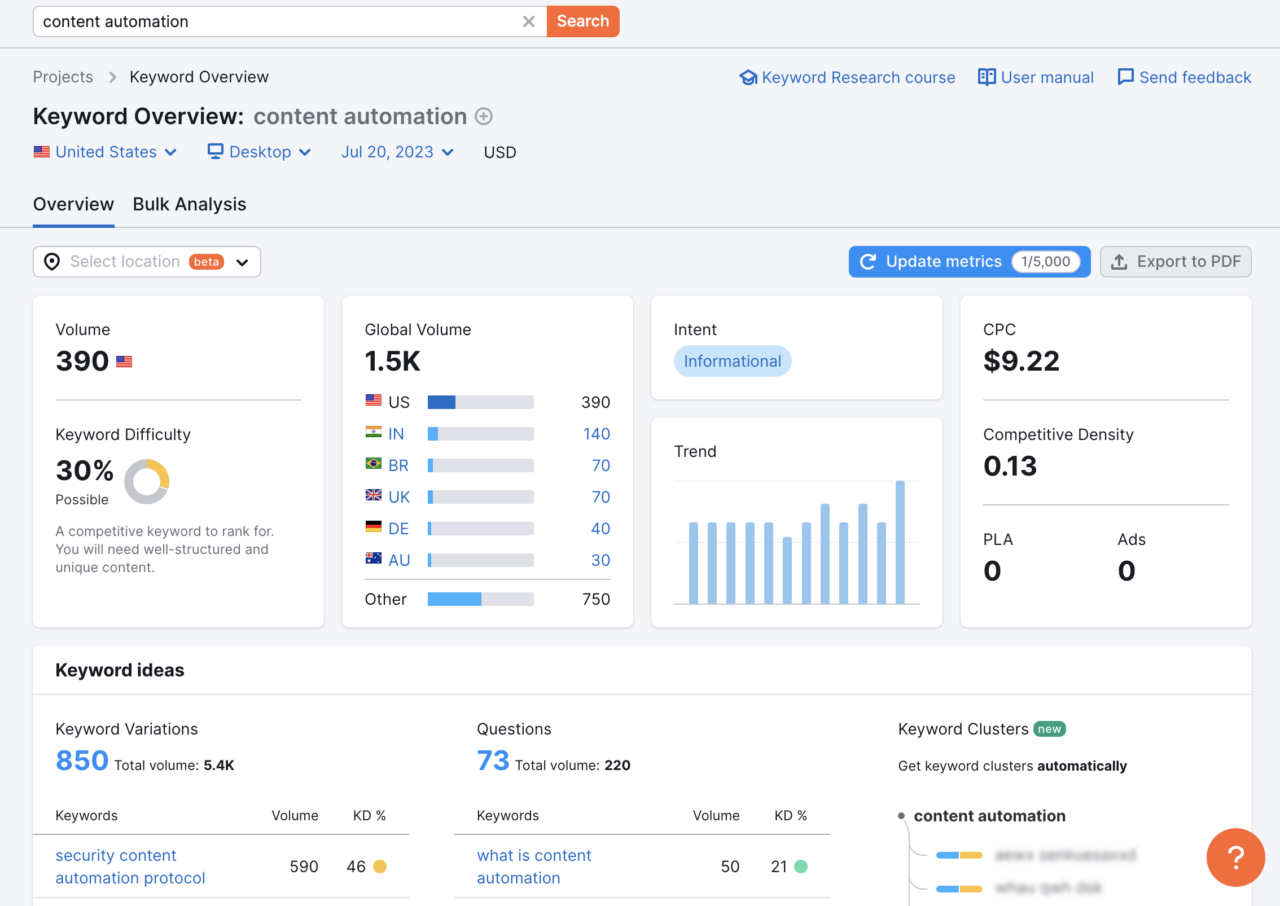
You can also use Semrush to build topic clusters, analyze your competitors, and identify popular topics and pain points. To start, click on the Content Marketing dropdown menu, select Topic Research, and enter a potential topic for your content in the search bar:

For a more market research-driven tool, CrawlQ is a “predictive audience modeling tool that combines humanized AI with proven marketing frameworks to dramatically improve your engagement and content ROI.” In other words, it helps you hone in on what your audience actually wants.
It offers in-depth data and market research on your target audience, competitors, and content to help you better understand your audience, niche, and content needs:
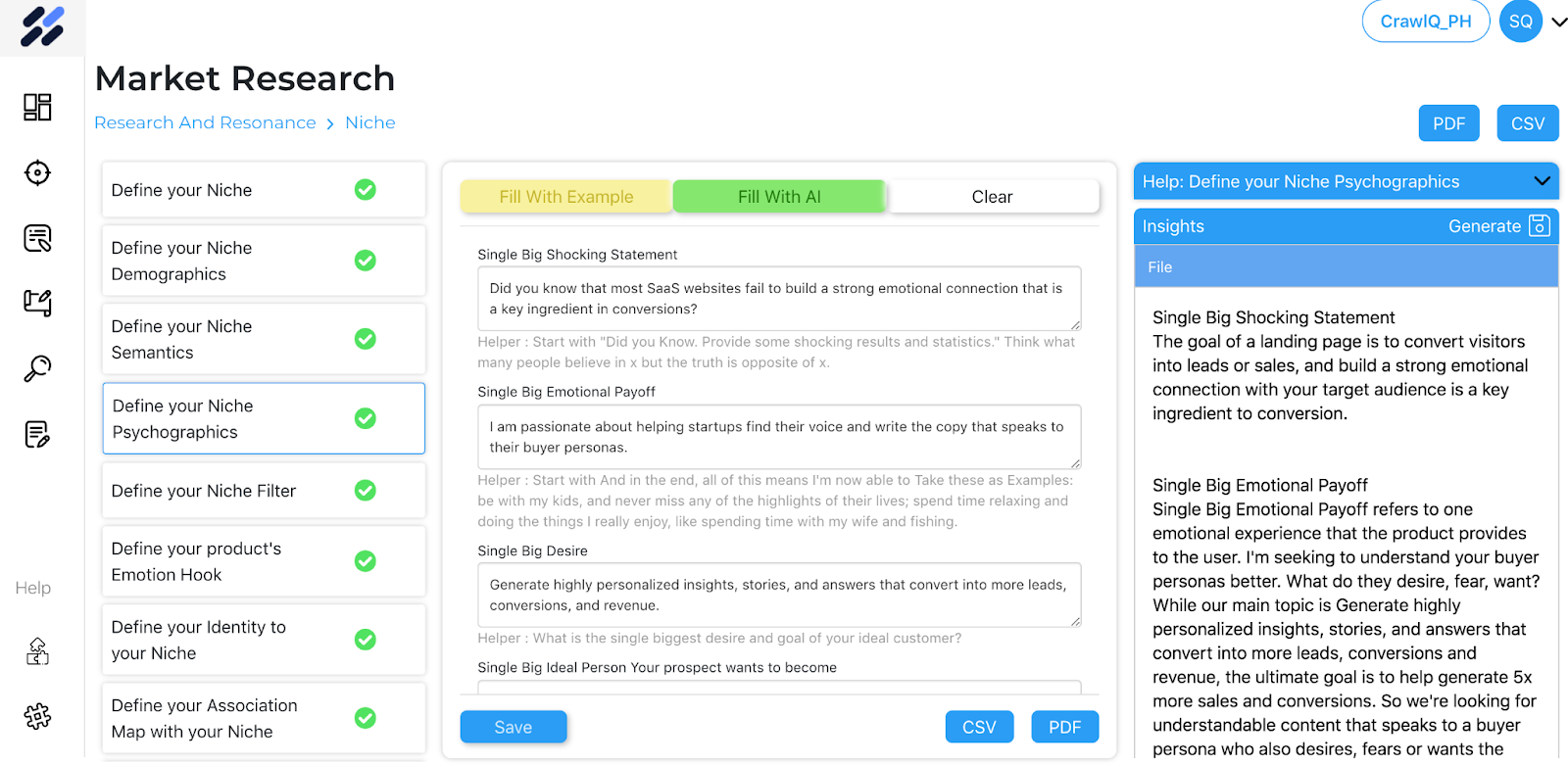
Twinword uses AI to help you find high-ranked keywords and phrases for your content. Just type in a keyword, and you’ll have access to keyword ideas, popular topics based on the keyword, average monthly searches, competition and more. It has advanced filtering features, such as by user intent or keyword patterns:
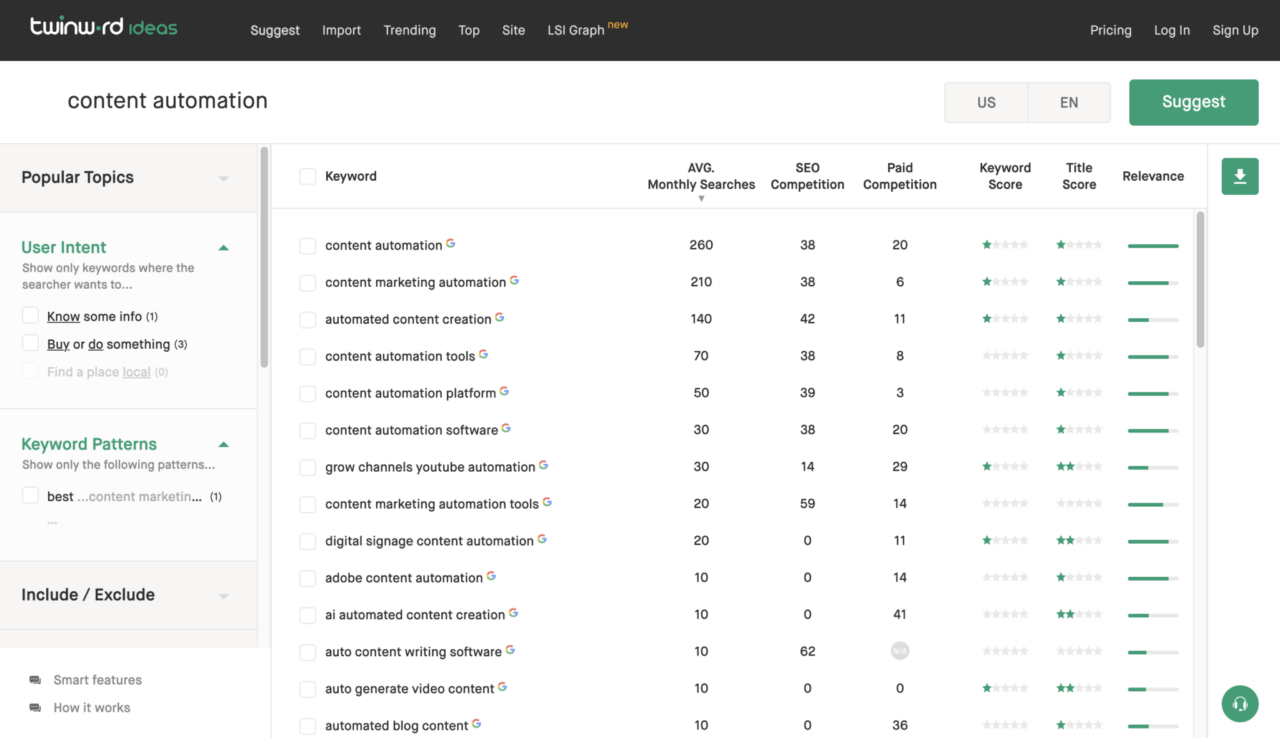
These tools will help you identify the keywords and topics most relevant to your business, as well as gain valuable insights into your audience’s interests and behaviors. You can then leverage this knowledge to craft compelling content that drives engagement and fuels your business growth.
Dive Deeper: SEO Keyword Research Made Easy in 2023
Step 2: Automate Content Generation Using AI
Once you have a better understanding of your content needs, you can start automating the content generation process using AI.
Whether you are looking for blog posts, social media updates, product descriptions, or email newsletters, AI-driven writing tools can not only save you time and effort (something we all need), but also ensure consistency across platforms. With the information you gained in the first step, it’s time to generate the content.
Jasper
One of the most popular AI tools for content generation is Jasper. You can choose from over 50 templates, provide specific details to match your content needs, and even teach the AI your brand voice.
If you’d like to create an article with Jasper, for example, all you have to do is fill in the template. It’s important to be as detailed as possible for the most accurate results. You can provide the title, content description, tone, keywords you researched, language, etc.
Then hit Compose and just like that, you have a newly generated article waiting for you:
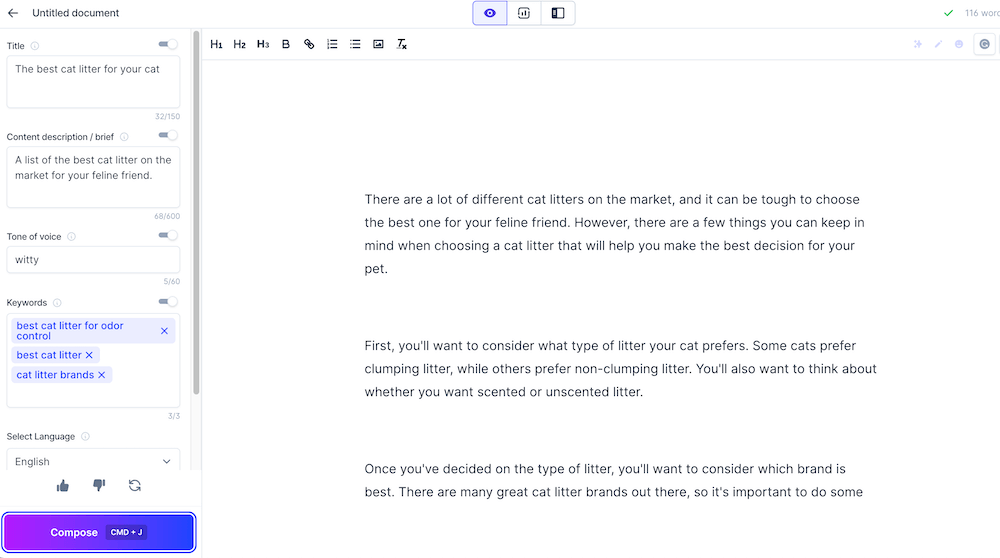
Copy.ai
While Jasper is a great tool, it is a bit more on the pricier side.
For a more affordable option, Copy.ai is an excellent alternative. It’s highly customizable, includes templates, and provides nearly 100 prompts and tools, allowing you to streamline content for multiple platforms and needs:
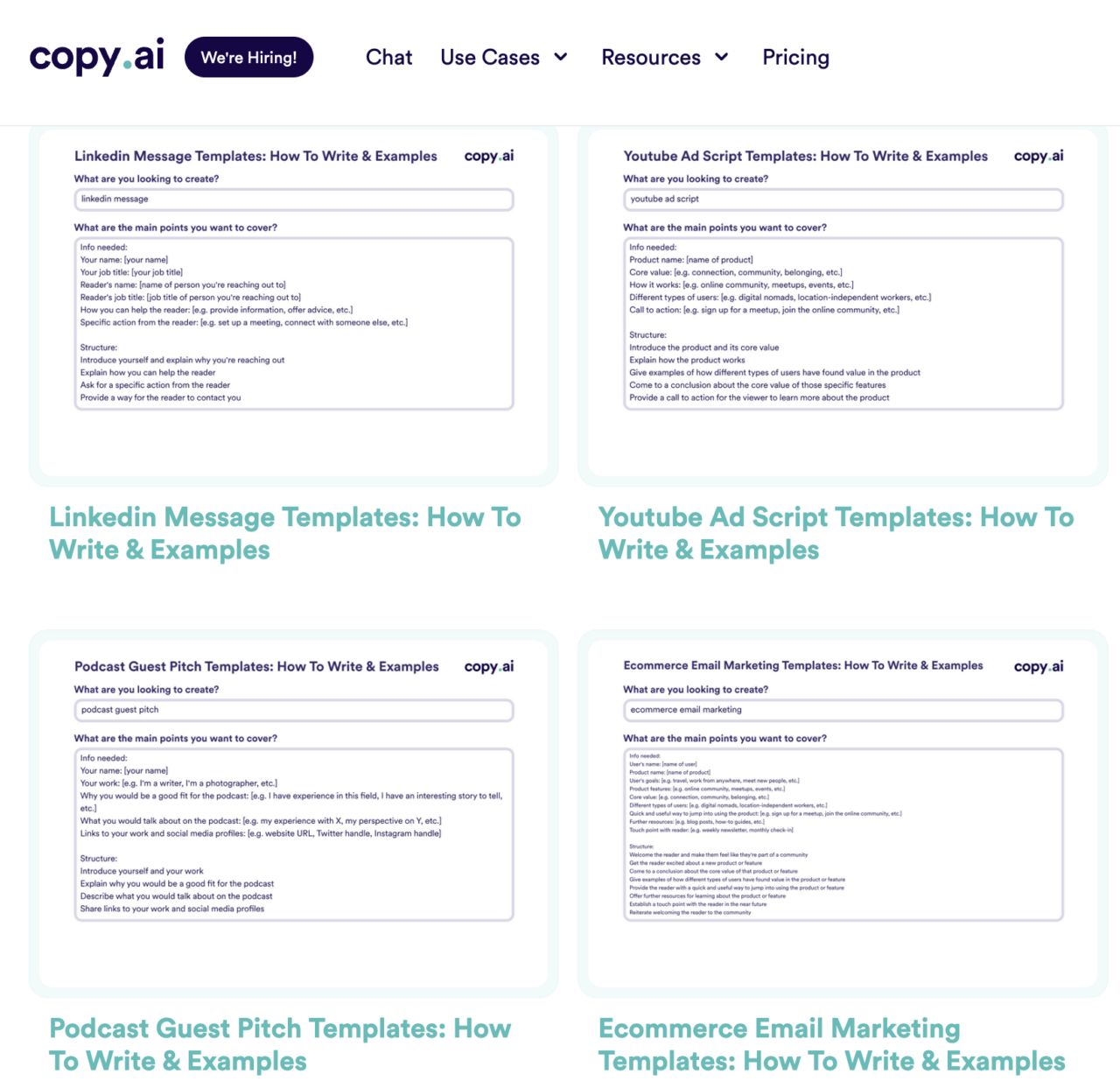
Or you can simply choose from a variety of prompts and fill in the blanks. Copy.ai also has a tool that improves your prompt to provide the most accurate responses:

SurferSEO
If you’re familiar with SurferSEO, it now has a “write with AI” feature:

You plug in your keyword(s), select your tone of voice, review the list of competitors you want to beat, and then review/amend the outline:

After clicking “Create,” go get a cup of coffee and wait for it to complete the AI-written article, complete with Surfer’s usual content score:

Dive Deeper: How to Use ChatGPT for Powerful Content Creation (+ Examples!)
Automating Social Media Content Using AI
If you’re looking to optimize and automate your social media content, check out Predis.ai, which defines itself as “ChatGPT + Canva + Hootsuite.” It’s a social media marketing tool that uses AI to generate text, images, and videos (e.g., Instagram Reels, YouTube Shorts, TikToks, and video ads):

Special Mentions:
- Frase: If you need a little more assistance, Frase can help with brainstorming, research, and content ideation in addition to generating copy.
- Writesonic: For marketing-related content, this tool provides templates for product descriptions and ads, such as Facebook, Google, and LinkedIn ads.
- Ocoya: This takes your social media content a step further by analyzing data to create relevant and optimized hashtags and captions for images you want to post. It also generates videos, images, and gifs in minutes, cutting down your social media content production time significantly.
- vidIQ: If you need help streamlining your YouTube video creation process, this is an excellent source. Just provide the AI with a video idea, and it will generate a script, voiceover audio, keywords, and more.
Picking the Right AI Tools
The number of options available can be overwhelming, so feel free to test different AI tools to find the one (or few) that best fits your needs. Here are some questions you can ask yourself to narrow your search and ease the decision process:
- What type of content do you primarily focus on (e.g., blogs, newsletters, or product descriptions)?
- Are there any integration needs with your content management system or workflow?
- What level of customization and control do you require over AI-generated content?
- What is your budget, and how does it align with available AI tools on the market?
Dive Deeper: AI Writing Tools and Their Takeover in Content Creation: What It Means for You
Step 3: Personalize Your AI-Generated Content
Now that you know how to automate your content-generation process, the next step is personalization.
Personalizing your AI-generated content helps it stand out, match your style, and drive meaningful engagement. The goal is to humanize AI content through training and detailed prompts.
Style and Brand Voice
First, determine the style, tone, and intent of the content you want your AI to emulate. This could be formal, informal, humorous, serious, convincing, helpful, etc.
Next, clarify your brand voice. This could include elements like your mission, values, and unique selling proposition.
Once you have a clear definition of how you want your content to sound, you must train the AI model. You can do this by providing the AI with blog posts, emails, reports, or any content that exemplifies your style and brand voice.
Request Content
Now, it’s time to request content from the AI. How you word your prompt plays a crucial role in receiving personalized content:

Include the tone and style, details on the content you want and key brand elements, such as specific phrases or keywords associated with your brand. Some tools also allow you to add URLs as examples of how you want the tone or writing style.
Let’s say you want a blog post on content automation that is informative yet fun. Here’s an example of a good initial prompt:
“Based on the writing style of [insert example URL here or paste content below prompt], write an informative 500-word blog post in a lighthearted and witty tone on how to automate content production. Include popular AI tools for automating content production.”
After your first prompt, you can test the output and keep fine-tuning the inputs and settings until you get the desired result. For instance, you can ask the AI to make the content longer, change the tone, or even add details to better curate the content you want.
Note: If it’s a conversation-thread AI writing tool, stay in the same thread so it can reference previous attempts and instructions.
Step 4: Optimize Your AI-Generated Content
It’s time to take your AI-generated content to the next level. And you guessed right: there are AI tools to do just that.
First up, let’s talk search engine optimization, the practice of driving traffic to your content. Getting high SEO rankings takes lots of time, effort, and research, not to mention the very nature of SEO is constantly changing.
This is where AI comes in.
While you have your AI-generated content that matches your style and brand, there is still room to optimize it even further and bring in more traffic.
SurferSEO
Take SurferSEO, a powerful AI tool that uses machine learning and data-driven analytics to suggest how to improve your content’s SEO ranking. (We mentioned Surfer’s AI writer above, but this is to optimize any content that’s already written.)
Copy your AI-generated text and paste it into Surfer’s Content Editor. The AI will analyze your content and give detailed reports and suggestions on its SEO ranking, keyword utilization, and structure (e.g., words, paragraphs, headings) in real time. So, you can edit the text on the platform and watch your rank increase right before your eyes:

Grammarly
Once your content score is in the green (i.e. SEO-friendly), it’s time to edit and review. You don’t want to drive users away with messy content that is riddled with errors. You want to create a positive experience by ensuring that the text is clean, easy to read, and free of grammatical errors.
The most effective way to accomplish this is to run it through Grammarly.
Either paste your content directly into Grammarly’s platform or use its extension on a compatible word processing software, such as Microsoft Word or Google Docs. The AI writing assistant tool will comb through the text and highlight anything from tiny typos to structural issues:
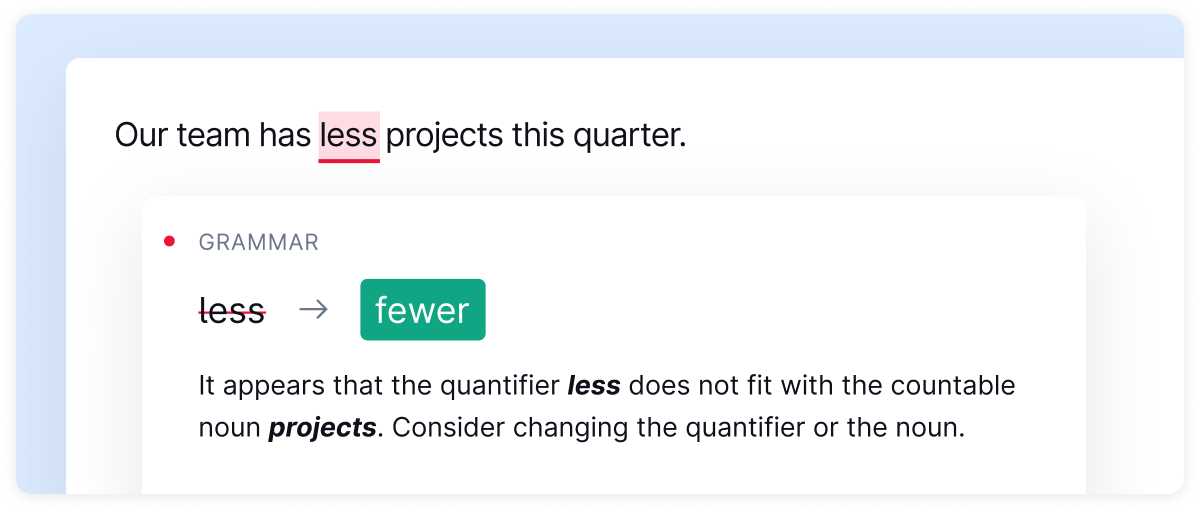
It gives you suggestions on how to fix these errors, helping your content read like a dream. All you have to do is approve the changes! You also have the option to tailor Grammarly’s suggestions to meet your content needs more closely.

INK
INK is an SEO optimization tool that provides real-time feedback on your content.
Start a Blank Document, provide your target keyword, and paste your AI-generated text into INK. You’ll get a list of relevant topics with suggested text to enhance your content and a variety of tasks to improve your SEO score, like putting your keyword in your first paragraph or limiting passive voice.
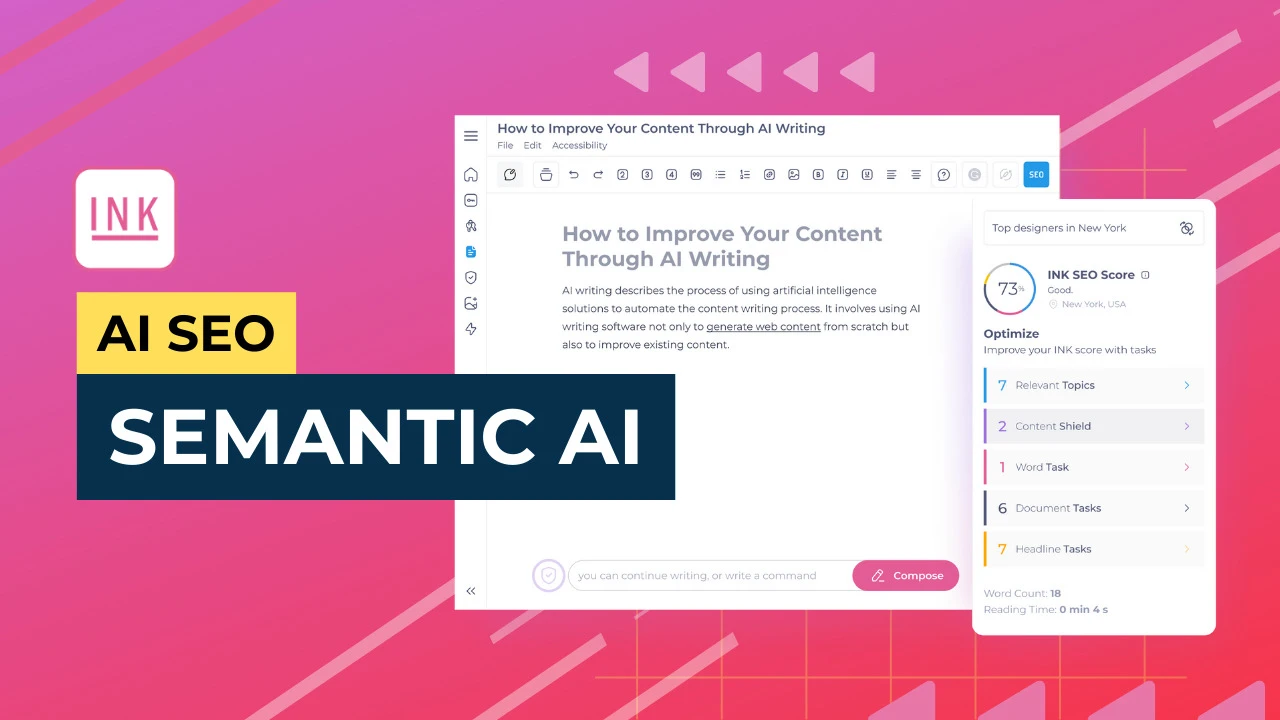
Optimizing Your AI-Generated Social Media Content
AI is a handy ally for optimizing social media content.
For instance, FeedHive has an AI writing assistant that provides insightful suggestions to improve your posts. The AI is fine-tuned for social media content, meaning it knows the ins and outs of high-traffic posts and how to get yours on top:

All you have to do is input your AI-generated post and request improvements. The AI will analyze the text and provide suggestions to boost the chances of reaching your target audience.

Dive Deeper: 10 Most Important Google Ranking Factors (& How to Optimize for Them!)
Step 5: Monitor and Enhance Content Performance
Now, it’s time to put your content out there and see how it performs!
When scaling content production, it’s important to understand your audience and know how to keep up with your new influx of content. Fortunately, there is no shortage of AI tools that can help enhance your content.
HubSpot, for example, gathers and reports data on your blog posts, website, and ads. It provides valuable insight into user behavior and preferences (e.g., landing page views, most popular blog posts, website engagement), which you can use to improve your content and marketing campaign:

Monitoring and Enhancing Social Media Content Performance
Have you ever found yourself wishing for a personal social media content strategist?
Then Tailwind is the app for you. This AI-powered tool collects and reports engagement rates for each post across all platforms and allows you to automate your social media publishing process. You can use the provided data and measure your content’s performance to enhance not only your content but also your scheduling strategy.

Special Mentions:
- BrightEdge: Enhance your content and user engagement with BrightEdge. This tool uses AI to explore your website and help you identify successes and gaps in your content, maximize your content outcomes and provide optimization recommendations.
- MarketMuse: This is an AI-driven content marketing platform that analyzes how your content measures up to others. Link your site and content, and the AI will give you detailed insights into the breadth, quality, momentum and rank of your content.
Dive Deeper: 12 Types of Interactive Content to Drive Better Engagement
Step 6: Refine and Improve Content Production
Finally, refining and improving your content production processes is essential. Here are some key tips to ensure your content scaling journey remains successful:
- Keep Fine-Tuning Those AI Models. As Step 3 suggests, fine-tuning and training AI models can significantly improve your AI-generated content outcomes. You can continue to test and refine the AI models you use to enhance its ability to match your style, brand and content needs.
- Regularly Monitor Content Performance. Staying on top of your reports helps you better understand your audience and content needs, allowing you to create a competitive advantage. With AI collecting and analyzing everything from view counts to user behavior, you can make data-driven decisions to improve your content and user experience.
For example, noticing a slight decline in traffic early gives you time to make adjustments, such as seeking out SEO or link building services. This can prevent significant loss that would have occurred without regular data monitoring.
- Don’t Be Afraid to Switch AI Tools. Each AI tool comes with its advantages and disadvantages, and sometimes it takes a little time to see which ones fit your content production needs best. Just because a platform was ranked first in an article, it doesn’t mean it will or should work for you.
You can refer back to Step 2’s “Picking the Right AI Tools” questions to reanalyze your current AI choices and find new ones as needed.
Dive Deeper: Best Content Creation Agency: Top 5 Choices for 2024
Last Word on Scaling Content Production Using AI
AI is paving the way for increased efficiency and business capabilities, and we are right at the center of it. Take advantage of this technology’s powers and watch your business flourish by following these steps to scale your content production.
Need some help getting started? Single Grain is here to assist you throughout the process. Our experts will develop a conversion-driven, AI content marketing strategy tailored to your content needs. In no time, you will be leveraging AI to scale your content production like a pro.
With the right combination of AI-powered efficiency and human creativity, you can drive your business forward and get closer to content goals that once seemed out of reach.
If you’re ready to level up your content with AI, Single Grain’s AI experts can help!👇
Related Video
More posts about AI tools:
* ChatGPT Alternative: Why Bard Is Our New Choice
* How to Leverage AI Content Writing Tools Efficiently
* How to Use AI Generated Video Tools for Marketing
* ChatGPT Marketing: Creative Ways to Up Your AI Game
* 100+ ChatGPT Prompts to Enhance Your Marketing Campaigns
* Using Chatbots and Generative AI for Sales Growth
* 7 AI Marketing Tools to Streamline Your Digital Marketing Strategy
* Jobs That Will Be Replaced by Marketing AI in 2023



